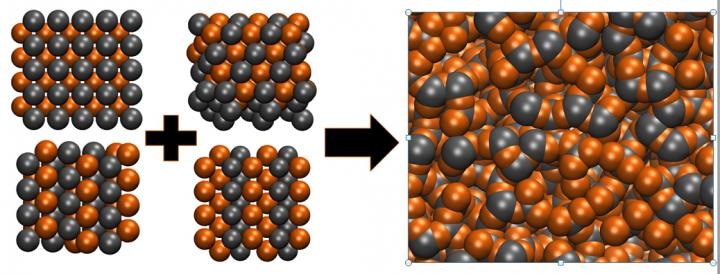Aug 3 2016
 This is a visual representation of the difference between an organized, crystalline structure and an amorphous glass structure. (Credit: Eric Perim Martins, Duke University)
This is a visual representation of the difference between an organized, crystalline structure and an amorphous glass structure. (Credit: Eric Perim Martins, Duke University)
A new way to predict which alloys will produce metallic glasses has been discovered by scientists. The research could lead to new powerful, conductive materials.
When molten metal cools at a rapid pace, without giving the atoms time to organize themselves in an ordered, crystalline form, it leads to the formation of metallic glasses.
The resulting materials have a number of useful properties. As they are metals, metallic glasses are tough, hard, and possess good thermal conductivity. Their disorganized structure makes them hard to corrode but easy to process and mould.
These desirable characteristics provide metallic glasses with numerous uses in applications such as nuclear reactor engineering, structural reinforcements, razor blades, and electrical appliances.
Although metallic glasses have been in existence for many years, scientists were unsure which combinations of elements would result in their formation. Scientists have had to experiment in laboratories with different combinations, with only a few rules to guide them in endeavors that are both highly expensive and time consuming.
A recent collaborative study conducted by researchers from Harvard University, Yale University, and Duke University has led to the development of a new method that can predict which binary alloys can lead to the formation of metallic glasses. The researchers used computing and compared the numerous pockets of various energies and structures that are present in a solidified alloy.
The research finding has been reported in the 2nd August, 2016 issue of Nature Communications.
When you get a lot of structures forming next to one another that are different but still have similar internal energies, you get a sort of frustration as the material tries to crystalize. The material can't decide which crystalline structure it wants to converge to, and a metallic glass emerges. What we created is basically a measure of that confusion.
Eric Perim, Postdoctoral Researcher, Duke University
In order to find out the possibility of an alloy forming a glass, Perim, Curtarolo and their teammates broke the alloy’s chemistry down into a number of fractions, each containing a few atoms. The researchers then used a prototype database to stimulate the numerous structures that each fraction can potentially form.
The prototype database, known as AFLOW library, contains information regarding the commonly found atomic structures in nature. The program uses these examples to compute how a new combination of elements would look based on these atomic structures. The atomic structure of salt or sodium chloride can be used to create a potential structure of copper zirconium.
These simulations provide an estimate of the characteristics of the various potential structures of the materials. The characteristic known as atomic environment analyzes the geometrical arrangement of the atom’s nearest neighbors. The energy stored in these atomic structures is analyzed by another characteristic.
In order to discover the possibility of an alloy forming a glass, the program compares the numerous structures that are present in the material based on these two characteristics.
If the energy in two neighboring groups of atoms is similar, these groups will form different structures. However, if this process is interrupted by the rapid cooling, then it results in the formation of a metallic glass.
The big advantage to our work is that it's high-throughput, because doing this experimentally is way too time-consuming. You cannot check all compositions of all systems in the laboratory. That would literally take forever. The idea behind this is that we can screen a large number of materials in a couple of days and single out the most likely ones that should be checked out.
Cormac Toher, Assistant Research Professor, Duke University
The researchers tested their confusion-measuring program to check if it can correctly predict known metallic glasses. The program showed a success rate of 73%. The researchers hope that by expanding the stimulation and structural information in the database they can improve the accuracy rate.
The initial work of the researchers has led them to believe that nearly one-sixth of the alloys in their system can form metallic glasses. This means over 250 potential materials, out of which only 24 have been found.
If you go to Venice you'll see people blowing bottles of glass. You can do that with metallic glasses as well. You can make lightweight, very durable objects without any seams. But trying to scale these up is difficult. The larger the lump, the longer it takes its center to cool, and the more likely it is to form a normal crystalline structure. But there might be undiscovered chemical combinations that would be easier to work with, cost less, or have other, more desirable properties. We just have to figure out where to look for them.
Stefana Curtarolo, Professor, Duke University
In addition to perfecting their outcomes, the scientists intend to expand their algorithms to include alloys with three elements. Although they are difficult to model and are time-consuming, the likelihood of these alloys forming metallic glasses is higher. However, the database has only 10% of the entries for these alloys as well as binary alloys, so the computer cluster of the world will have to suffice for the time being.